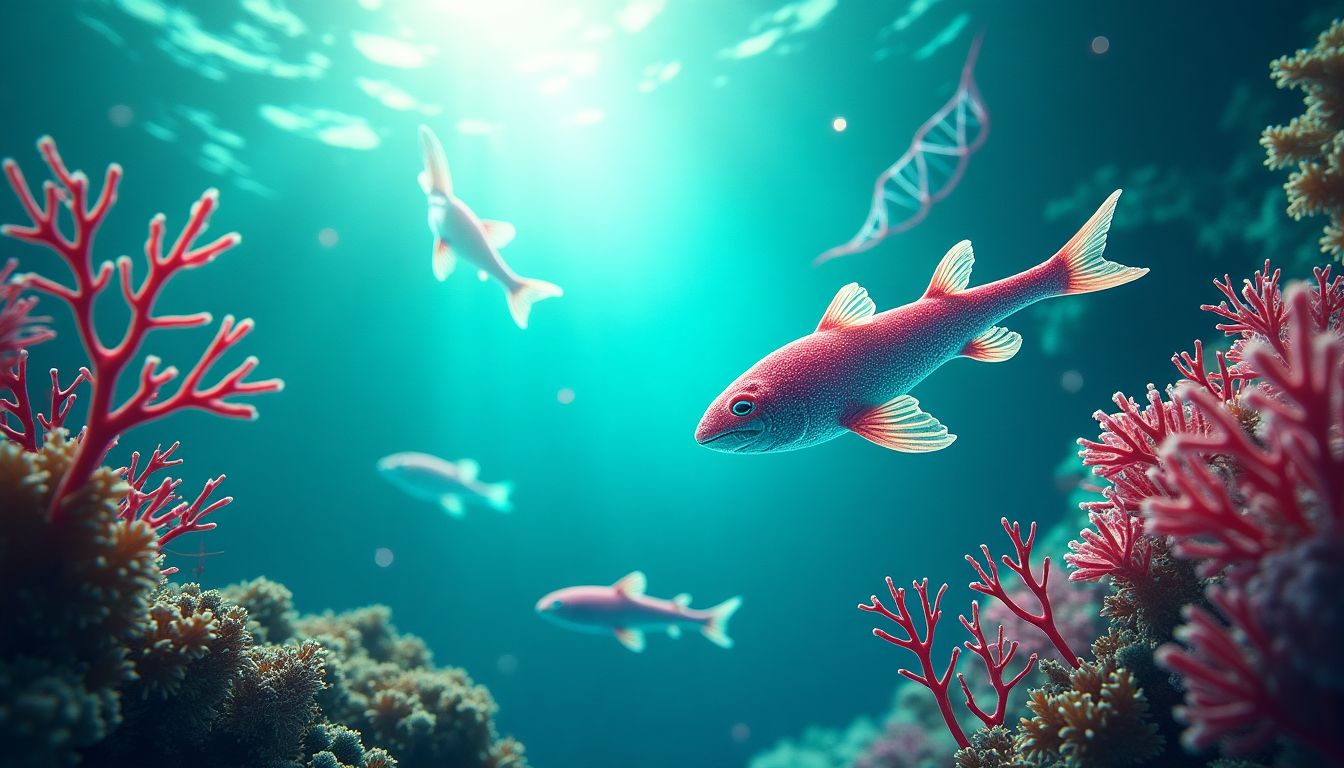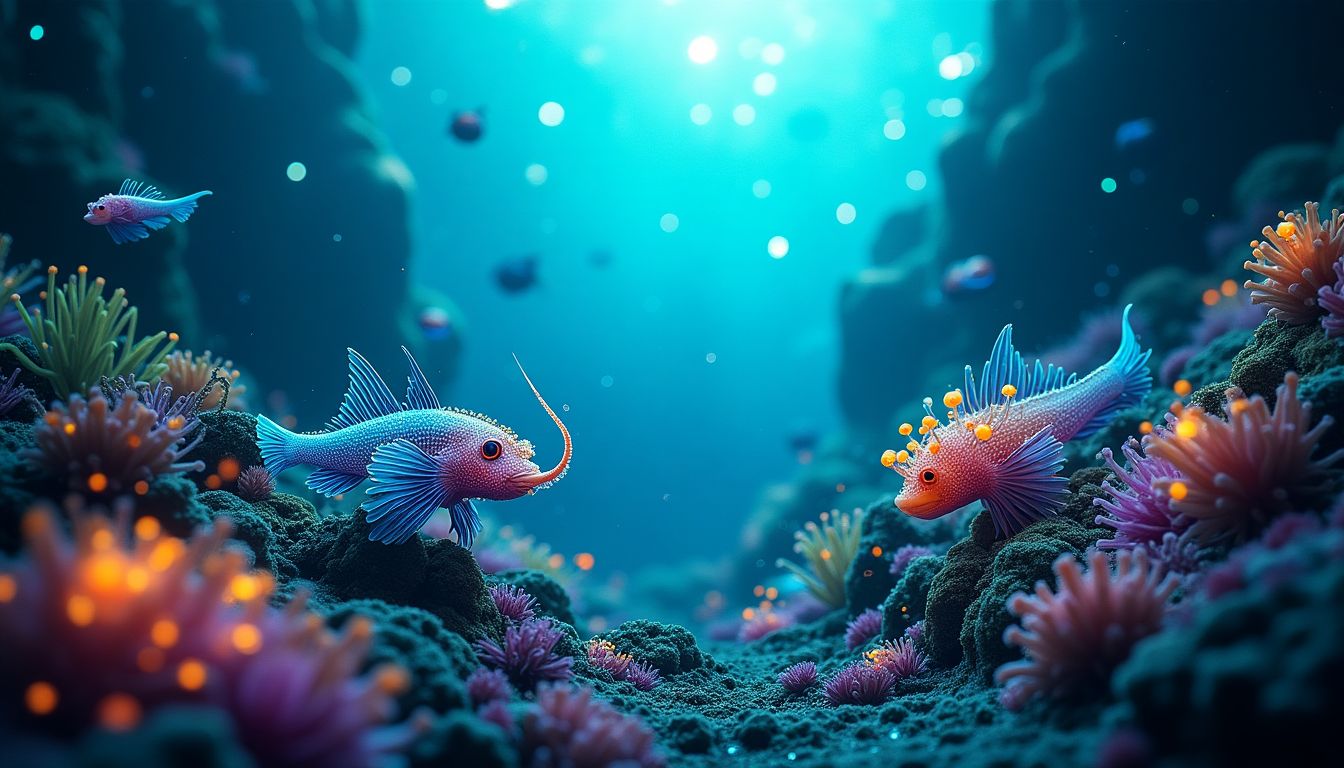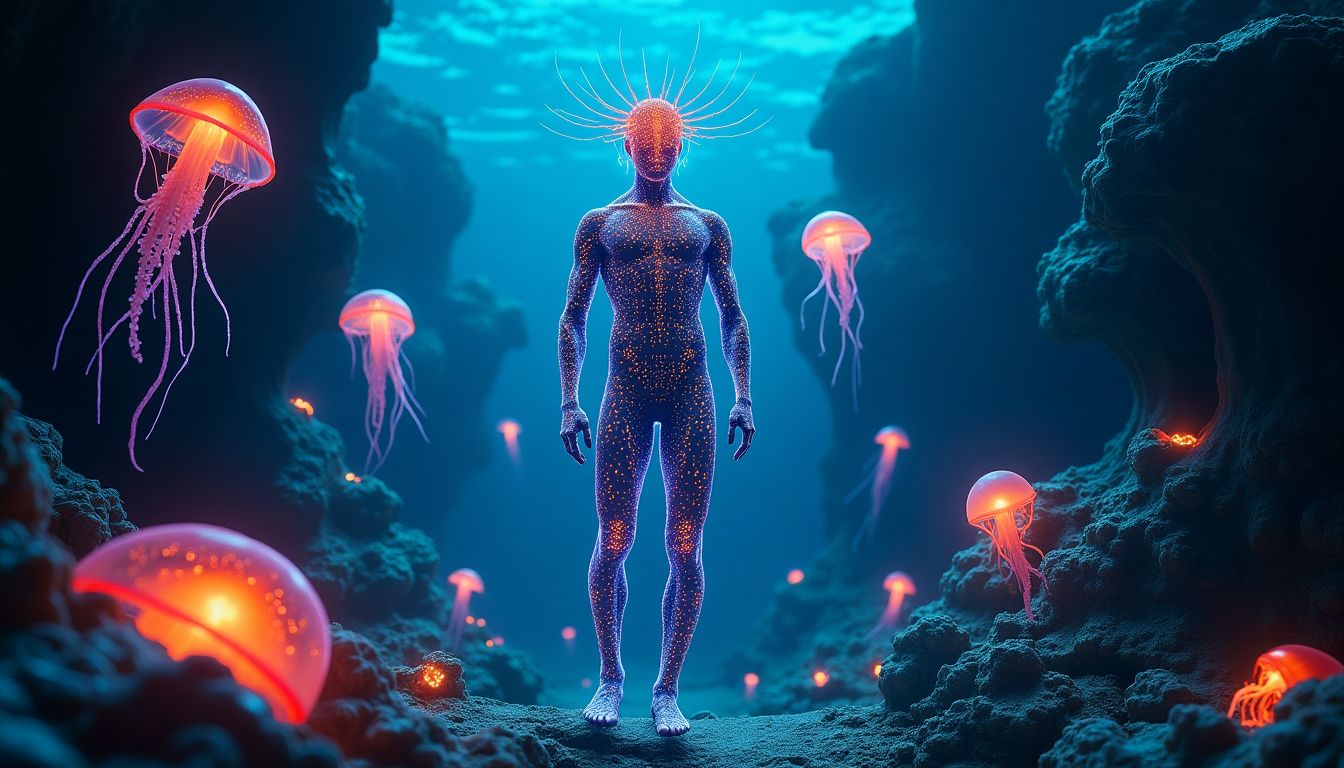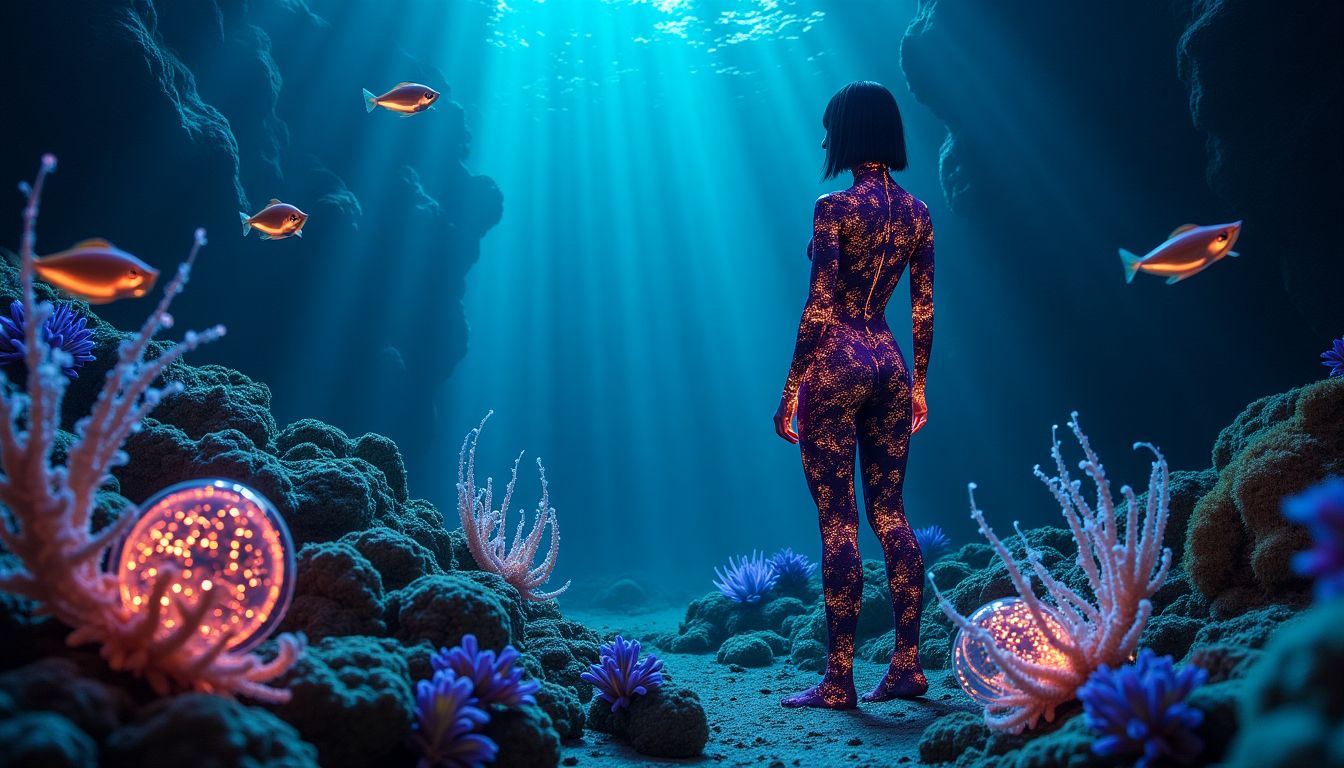Introduction: The Call of the Abyss
The oceans are a desolate place, devoid of light and sound, but they hold the essence of life's very beginnings. – Unknown This thought-provoking concept tantalizes our senses and awakens our curiosity about the great unknown beneath the waves. The ocean, covering about 71% of the Earth's surface, is more than just a watery expanse; it’s an entire universe waiting to be explored. As we face issues like climate change and a reduced amount of resources on land, the depths of the sea call out to us, promising new possibilities. But what if we could evolve to survive the crushing pressure and frigid waters found below the surface? What if we could embrace our aquatic aspirations, turning our DNA into a tailored suit to fit the pressures of the abyss?
Renowned researchers and thinkers, including Jacques Cousteau, who famously explored the watery wonders, Sylvia Earle, a pioneer in ocean conservation, and Niels Bohr, a physicist who delved into the molecular life, have each highlighted the ocean's profound significance. They remind us that the ocean is not simply the ‘final frontier’ but an essential part of our shared planet that we must learn to inhabit sustainably. This existential challenge presents a staggering opportunity to think bigger: to not only explore the depths but to potentially live and thrive within them.
Could genetic engineering hold the key to human adaptation beneath the waves, allowing us to become not just visitors but actual inhabitants of the deep? In this journey, we’ll explore how the marvels of genetic engineering can lead to unprecedented opportunities to confront nature’s most formidable challenges.
1. The Science of Pressure: Understanding the Deep Sea Environment
Exploring the depths of the ocean is like peeking into a world where nature really lets loose. Deep sea exploration brings a fantastic array of challenges uniquely tailored to test human capabilities due to the immense underwater pressure. At depths exceeding 1,000 meters, the pressure is over 100 times that of the atmosphere at sea level, making survival as easy as trying to juggle jellyfish while riding a unicycle!
1.1 The Characteristics of Deep Ocean Pressure
The pressure at great depths can reach more than 1,000 atmospheres, which is akin to having the weight of about 50 elephants standing on your little finger—assuming your finger could survive that sort of ridiculous trial. This harsh reality results in fascinating adaptations among marine life that can encourage innovative approaches for human adaptation. From how bodies are shaped to how proteins function, everything must adapt to conquer the abyss.
1.2 Natural Adaptations in Marine Species
Take a moment to consider creatures like the anglerfish or the mysterious deep-sea squid. These animals flaunt design features that allow them to thrive in near-impossible conditions, such as flexible bodies that avoid breaking and specialized proteins that resist the crushing pressure. By studying these natural adaptations, scientists can uncover invaluable insights that pave the way for genetic engineering approaches in humans. Why not borrow ideas from our fishy friends? It’s a fish-out-of-water story worth exploring!
2. Genetic Engineering: Possibilities and Technologies
Recent advancements in genetic engineering are like a sci-fi movie coming to life. Technologies like CRISPR and gene therapy have opened the door to exciting possibilities for humans to adapt to the extreme underwater environments of the deep sea. But how exactly will these technologies help us live down there without turning into human-shaped fish sticks?
2.1 Overview of Genetic Engineering Techniques
To cut through the jargon, let’s break down some cool genetic engineering techniques. One of the stars of the show is CRISPR, a tool that allows scientists to edit genes with precision. It’s like having a high-tech word processor for DNA. Want to tweak a gene here or fix a problematic one there? Done! This technology has huge implications for enhancing our ability to withstand pressure, temperature, and other factors in the deep sea.
Another method is gene therapy, which is all about introducing new genes into cells to help combat diseases. Imagine swapping the “bad” genes for some that better fit life at the ocean's bottom. This could lead to humans who are not only better at holding their breath but can also handle the pressures of the abyss like champs.
2.2 Successful Case Studies: Animals as Models
So, where do we find inspiration for all this genetic wizardry? Enter our ocean friends! Animals that thrive in the deep sea have unique adaptations that could fuel our research. Scientists are examining how organisms like the squid and the iconic anglerfish survive in their high-pressure environments.
For example, studies have shown how the squid's blood produces proteins able to withstand extreme pressures. This is like their own version of a deep-sea superhero cape! By learning from these remarkable creatures, we can grasp the secrets of what makes them tick and hopefully apply that knowledge to human genetic engineering. In a few years, we might be adding “squid whisperer” to our list of qualifications!
3. Ethical Considerations in Human Genetic Modification
No great adventure comes without its share of ethical questions. As we swim deeper into the waters of genetic engineering for deep-sea adaptation, we need to navigate tricky philosophical waters. Are we "playing God," or are we merely extending our range as life's curious explorers? Let's dive into some of these heavy ideas.
3.1 The Debate on Playing God
The thought of modifying human DNA raises eyebrows, and rightfully so! Some people argue that tinkering with our genetic makeup is like opening Pandora’s Box. “What if we create a human who can breathe water?” they say. “What if they develop gills, start a fish revolution, and kick all the regular humans off the beach?” Okay, maybe not that dramatic, but it’s a valid concern.
It's crucial to ask ourselves: Should we be allowed to alter what it means to be human? Exploring these ideas could lead to groundbreaking developments, or it might land us in a sci-fi scenario where engineered humans wear capes and battle natural selection. Even better, maybe they collaborate with dolphins for marine missions! The key is to approach genetic engineering with care and responsibility.
3.2 Regulatory and Policy Frameworks
To avoid flying blind, we need rules and regulations guiding genetic modifications. Existing frameworks vary but often focus on safety, effectiveness, and ethical considerations. The World Health Organization and other organizations are working on international guidelines to ensure research and applications are conducted responsibly.
Creating a solid policy framework will involve input from scientists, ethicists, and society. Balancing progress with precaution is essential. Just imagine the debates about underwater colonies and whether or not they should allow octopus art festivals! But there must be solid guidelines ensuring that we proceed thoughtfully when navigating the uncharted waters of human evolution.
4. The Role of AI in Genetic Engineering Research
Artificial Intelligence (AI) is revolutionizing every area of science, including genetic engineering. In the quest to adapt humans for life in extreme ocean depths, AI plays a crucial role. It helps scientists make sense of complex genetic information and optimize their research.
4.1 AI in Genomics: Analyzing Genetic Data
AI algorithms can analyze massive amounts of genetic data, identifying patterns that might be overlooked by humans. Here’s how AI enhances genomic research:
- Speed: AI can process data faster than any human researcher.
- Accuracy: Advanced algorithms reduce errors in data analysis.
- Pattern Recognition: AI identifies genetic sequences associated with specific traits.
For example, companies like Illumina are using AI in their gene sequencing technologies to understand how different genetic modifications might work in deep-sea scenarios.
4.2 Predictive Models for Human Adaptation
AI can create predictive models that estimate how genetic changes might affect human physiology under deep-sea conditions. These models could save researchers time and resources by allowing them to simulate various genetic scenarios before actual implementation. The processes include:
- Data Collection: Gather information from both human and marine genetic research.
- Model Development: Use AI algorithms to create simulation models of genetic modifications.
- Outcome Predictions: Analyze potential outcomes and their impacts on human adaptation.
With AI driving these simulations, researchers can push the boundaries of what we thought was possible for human life in extreme environments.
5. Future Prospects: A Society Under Pressure
Imagine a world where genetically engineered humans thrive in the depths of the ocean. This futuristic vision comes with its own set of opportunities and challenges as society learns to adapt beneath the waves. What could this subaquatic society look like?
5.1 Socioeconomic Implications of Deep-Sea Colonization
As we explore the potential for human settlements in the deep sea, we must consider how these communities will function. Here are some key aspects:
- Resource Management: New technologies will likely emerge to harness resources, such as deep-sea minerals and underwater farming.
- Governance: Who governs these underwater societies? International laws, like the United Nations Convention on the Law of the Sea, may need to be updated as people settle beneath the ocean waves.
- Economic Structures: Will deep-sea societies use currency? What would trade look like between ocean and land-dwellers?
Learning from existing underwater research habitats, such as Biosphere 2, we can predict that life under the sea will require innovative answers to these questions.
5.2 Psychological Factors: Living in Extreme Conditions
Life in the depths won't only test our bodies but also our minds. Humans are social creatures, and living in isolation can pose significant psychological challenges. Consider these factors:
- Isolation: Residents may experience feelings of loneliness, requiring planning for social interaction.
- Stress Management: Living under constant pressure could create unique stresses that must be managed through resilient community structures.
- Adaptation Challenges: Individuals will need support to adapt to the new environment, both physically and emotionally.
As we move closer to becoming an underwater society, we must prioritize mental health support systems to ensure the well-being of future inhabitants.
6. AI Solutions: How Would AI Tackle This Issue?
In today's world, artificial intelligence has the potential to transform our understanding of genetics, particularly when it comes to deep-sea adaptation. AI can accelerate research, fine-tune genetic modifications, and even simulate outcomes, making it an invaluable ally in the quest for human resilience beneath the waves.
6.1 Research Optimization and Data Handling
One of the primary ways AI contributes to genetic engineering research is by streamlining data analysis. Large datasets generated from sequencing the genomes of deep-sea organisms can be overwhelming. Enter AI tunes, which can categorize, analyze, and extract actionable insights much faster than human researchers ever could. This data handling also aids in identifying potential genetic modifications that could enhance human survival in extreme underwater conditions. For instance, the IBM Watson platform has shown promise in genomics by utilizing machine learning to identify genetic variants linked to specific traits, allowing for a more targeted approach in genetic modifications.
6.2 Simulation of Genetic Modifications
With AI's advanced modeling capabilities, researchers can simulate the effects of various genetic modifications before they are tested in real organisms. This predictive power provides invaluable insights, as teams can optimize genetic changes for desired traits, such as pressure tolerance or enhanced metabolic efficiency. Technologies like deep learning can generate intricate models that predict the performance of genetic modifications and their long-term impacts on human physiology. For example, DeepMind has already pushed the envelope in AI research by using neural networks to predict protein folding, a breakthrough that holds relevance for understanding how modified proteins might function in humans under pressure.
Actions Schedule/Roadmap (Day 1 to Year 2)
Implementing a project of this magnitude requires a carefully outlined roadmap. Below is an action schedule that combines interdisciplinary methodologies, cutting-edge technologies, and collaborative efforts across various organizations:
Day 1: Project Kickoff Meeting
Bring together key personnel from genetic research institutions, marine biology departments, AI specialists, and policymakers. This meeting aims to define the project's vision, strategic objective, and allocation of roles.
Day 2: Initial Literature Review
The team conducts a thorough review of existing literature on deep-sea adaptations and current genetic engineering techniques. This review helps refine project goals and identifies gaps in existing knowledge that require further investigation.
Day 3: Data Acquisition
Collect genetic data from deep-sea organisms. Collaborations with universities such as Stanford University and marine research institutions facilitate access to vast environmental genomic databases.
Week 1: Establish Project Milestones
Setting clear goals with realistic timelines allows project progression to be tracked. Milestones include data analysis updates, simulation results, and ethical reviews, ensuring transparency and accountability throughout the project.
Week 2: AI Integration Planning
Work with AI specialists to evaluate which tools, like Google AI and NVIDIA Deep Learning, can be utilized to optimize data handling and genetic modification simulations.
Week 3: Begin Genetic Modeling
Initiate genetic modeling based on the data collected. The team will create models that analyze genetic variations linked to deep-sea adaptations, identifying promising candidates for modification.
Month 1: First Stage Report
Prepare a report on initial findings and project progress, highlighting successes, challenges, and areas needing further exploration. Use this as a foundation for future outreach and investment efforts.
Month 2: Ethical Review
Conduct an in-depth ethical review with bioethicists from renowned institutions like HHS Office for Human Research Protections, ensuring compliance with ethical standards and addressing potential concerns regarding genetic modifications.
Month 3: Initiate Field Studies
Collaborate with organizations such as NOAA Ocean Exploration to conduct preliminary field studies that validate genetic data in real-world deep-sea environments.
Year 1: First Iteration of Genetic Engineering
Conduct the first attempts at genetic modifications based on extensive research and modeling efforts. The aim is to test the modifications in living organisms known for their deep-sea adaptation capabilities.
Year 1.5: Evaluate Outcomes
Assess the results of initial genetic modifications and compare them against predictive models. This evaluation phase is critical for refining approaches and enhancing our understanding of deep-sea biology.
Year 2: Expand Research Team and Funding
Seek additional funding through grants and partnerships with private-sector entities like Illumina. Expand the research team to include more specialists in genetics, marine biology, and ethics, ensuring a holistic approach to the project.
Conclusion: Looking Ahead to a Subaquatic Future
As we venture further into the unknown realms of our planet’s oceans, the fusion of cutting-edge technologies with genetic engineering offers thrilling possibilities for human survival and adaptation. Imagine a world where we’re not merely terrified tourists but architects of our subaquatic realities. The ocean is calling out to us, not as a distant frontier but as a necessity. We need this exploration not just to satisfy our curiosity but to confront the pressing challenges of climate change and dwindling resources.
By leveraging artificial intelligence alongside advanced genetic engineering, we could become masters of our fate—reshaping who we are to thrive where few humans have ever dreamed to dwell. Yet, as we stand on the brink of what’s possible, we must tread carefully and ethically, weighing our responsibilities as innovators against our shared humanity. The possibilities are both limitless and daunting. Will we harness the power of genetics and technology to adapt to new realities, or will we allow the wonders of the deep to remain forever out of reach? Let’s put on our scuba gear, roll up our sleeves, and dive into the future together. We might just uncover treasures beyond our wildest imaginations.
Frequently Asked Questions (FAQ)
What are the primary challenges of deep-sea exploration?
Deep-sea exploration is like going on a giant underwater adventure, but it comes with many unique challenges. Here are the main hurdles:
- Extreme Pressure: As you dive deeper, the water pressure increases dramatically. At a depth of 1,000 meters, the pressure is over 100 times greater than at the surface, which can crush submarines and underwater robots.
- Cold Temperatures: The deeper you go, the colder it gets. Many deep-sea areas are near freezing, making it tough for humans to survive without special gear.
- Darkness: The deeper you dive, the darker it becomes. In some areas, there’s no light at all, making navigation and exploration very difficult.
How could genetic engineering address these challenges?
Genetic engineering might provide us with superhero-like abilities to adapt to the harsh conditions of the deep sea! By modifying our DNA, scientists could help humans develop:
- Pressure Resistance: Changes to our body that allow us to survive high pressure levels.
- Enhanced Metabolism: New ways for our bodies to use energy and regulate temperature in cold conditions.
- Improved Breathing: Adjustments to our respiratory system for breathing in low-oxygen environments.
What ethical concerns might this research raise?
While the potential for genetic engineering sounds exciting, it also brings some serious questions. These include:
- Playing God: Is it right to change our DNA? Some people worry we could take things too far.
- Unforeseen Consequences: What if some changes lead to unexpected problems? Scientists are still learning about the long-term effects of genetic modifications.
- Consent for Future Generations: If we change our DNA, we could also change our children’s DNA. Should they have a say in this?
What role does AI play in genetic modification research?
Artificial Intelligence (AI) is like the superhero sidekick for genetic research! Here’s how it helps:
- Data Analysis: AI can sift through huge amounts of genetic data to spot patterns that might help in creating pressure-resistant genes.
- Prediction Models: AI can predict how new genetic changes might work, helping scientists make safer and better decisions about modifications.
How do scientists study deep-sea organisms for insights into genetic engineering?
Scientists often study unique deep-sea creatures that thrive under extreme conditions. For example, the anglerfish has evolved to survive the crushing depths. Some steps in their research include:
- Field Studies: Exploring the ocean to observe creatures in their natural habitats.
- Laboratory Experiments: Replicating deep-sea conditions to study how these creatures adapt.
- Genomic Analysis: Analyzing the DNA of deep-sea organisms to understand their unique adaptations.
Will we live in the ocean someday?
While it sounds like science fiction, it’s possible we may find ways to live underwater in the future. A society under the sea could focus on:
- Resource Management: How to use marine resources wisely without harming ecosystems.
- New Communities: Different social structures and forms of governance may develop in ocean habitats.
What are scientists looking to discover in the deep sea?
Scientists are driven by a quest for knowledge! Some of the things they hope to find include:
- New Species: Discovering creatures that have never been seen before.
- Medicinal Compounds: Investigating underwater organisms for potential new medicines.
- Climate Change Effects: Understanding how climate change impacts ocean ecosystems.
Wait! There's more...check out our gripping short story that continues the journey: The Abyss of Ambition
Disclaimer: This article may contain affiliate links. If you click on these links and make a purchase, we may receive a commission at no additional cost to you. Our recommendations and reviews are always independent and objective, aiming to provide you with the best information and resources.
Get Exclusive Stories, Photos, Art & Offers - Subscribe Today!





























1 comment